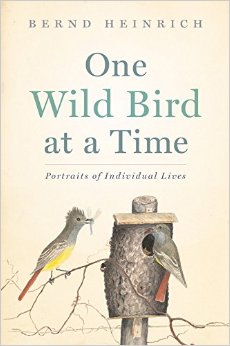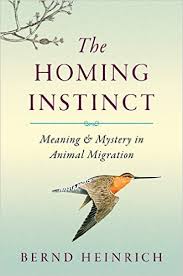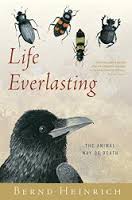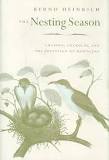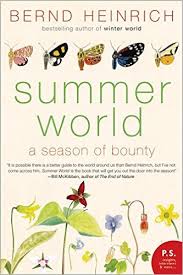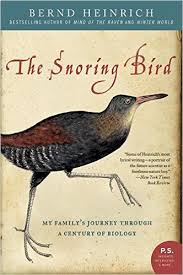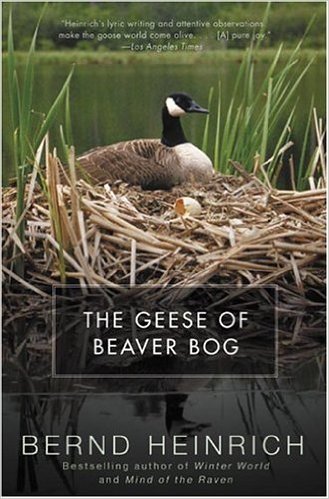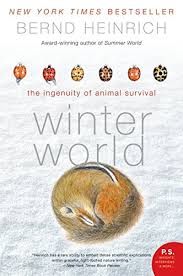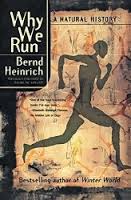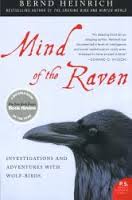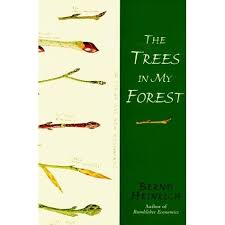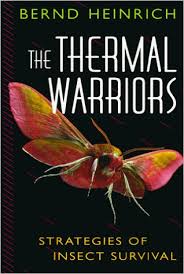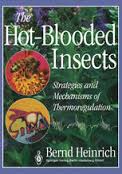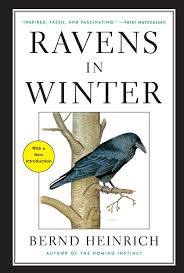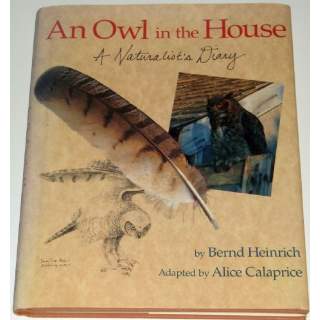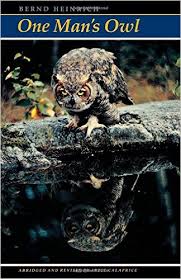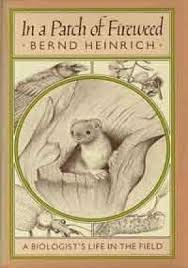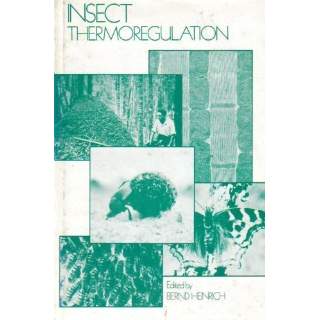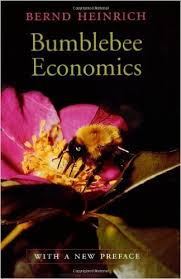A Complete Guide to Bernd Heinrich's Books
(Including the inside story behind each book, as written by Bernd Heinrich for The Naturalist's Notebook)
"Heinrich is a scientist and naturalist of the first rank, champion ultramarathoner, woodsman of skills seldom seen in modern times and...a nature writer of uncommon talent." —Edward O. Wilson
"Bernd Heinrich is not just a great naturalist writer, he's a great writer, period." —Bill McKibben
"He richly deserves the comparison to Thoreau."—Washington Post Book World
Picking a favorite book by Bernd Heinrich is a daunting challenge. His work spans birds, insects, mammals, seasons, science, life, death, running and a remarkable family saga. We hope you have read or will read many of his brilliantly insightful accounts of exploring the workings of the natural world, which have earned him a regular slot on bestseller lists and awards such as the John Burroughs Medal, the highest honor in the world of natural-history writing. You can explore Bernd's books by clicking on any cover shown below—you'll go to a page devoted to that book—or by scrolling down farther and reading about every title without leaving this page. Many thanks to Bernd for taking the time to share with The Naturalist's Notebook his memories of writing each of his books, currently at 20 titles and counting. Book 21 (on running) is already in the works.
Bernd Heinrich at work in his Maine cabin on an illustration for one of his books.
Below are Bernd's 20 books, listed in the order in which he wrote them. We thank him for taking the time to write an account of each book—how it came to be, what was going on with his life and work at the time, what reaction the book prompted. You'll see Bernd's remarkable career as a biologist unfolding as you read those accounts of his nearly four decades of memorable writing.
BUMBLEBEE ECONOMICS (247 pp., Harvard University Press,1979; republished with new preface in 2004)
From the book jacket of 2004 edition: "In his new preface Bernd Heinrich ranges from Maine to Alaska and north to the Arctic as he summarizes findings from continuing investigations over the past twenty-five years--by him and others--into the wondrous energy economy of bumblebees."
REVIEWS (5 of 5 stars on Amazon): “This is a remarkable and rewarding book, complementary to, yet in some respects going far beyond, its predecessors. It is highly recommended.”—The New York Times Book Review
“Heinrich is the author of several notable books about nature. This one, first published in 1979, is a classic, a fascinating, readable study of life as organized (sort of) by a most endearing little creature. A new preface summarizes findings of the last quarter-century. A splendid work.”—The Globe and Mail
“Extraordinary… The implications of work such as Heinrich's seem to me more resonant than the promise of a rich harvest of new research.”—Harper’s
“A magnificent book that combines the best of both writing and science...Heinrich has performed a masterful job of sharing his personal research efforts and those of others in his field. He has written an extremely interesting book and in the process has shown how one kind of organism can be used as a model to investigate behavior, physiology, ecology and evolution. Bumblebee Economics should serve as a model for good scientific writing.”—Matthew M. Douglas, Quarterly Review of Biology
BERND HEINRICH WRITES ABOUT BUMBLEBEE ECONOMICS:
This was my first book. It was not planned. But it has a history reaching back to vivid childhood memories. One of the most evocative of them is of a spring morning when, on our way to the village school through the woods, my sister and I crossed the black-pebbled trout brook by our cabin, as we did every day. But this time I stopped, arrested by the just-returned birds chirping in a big willow at its bank. The tree was resplendent in yellow catkins. As I stood transfixed, listening, I heard humming and saw black and rust-brown bumblebees buzzing from one yellow catkin to another. It was a magic moment that has always stayed with me.
About twenty years later this is what I told a professor at the University at Buffalo when he asked me, "Why did you decide you wanted to be a biologist?" I gave him the answer, describing the moment of meaning that I had sensed in its beauty. He was aghast, saying, "You are a naturalist!" as though I were unsuited for science. He was a physiologist. And then he cut the interview short, and despite my having been invited expenses-paid to fly there and be interviewed for their Ph.D. program, despite my 99th percentile in the graduate record exams in biology, I was dismissed, and not accepted into their program.
My masters thesis advisor at the University of Maine had more faith. I had started in his lab washing glassware, and ended up working on the respiratory metabolism of Euglena gracilis, a protozoan that could be induced by light to have chloroplasts. He wrote me a glowing recommendation to his alma mater, UCLA, where I was not only accepted, but also offered a research fellowship.
After another couple of years, during my Ph.D. qualifying exam at UCLA, one of the professors asked me the same question as the professor at Buffalo. Again, I answered exactly the same—the bumblebees and flower epiphany of beauty in mystery and meaning. They did not dismiss it. I had by then done research, and when I graduated and got my Ph.D. they awarded it "with distinction." I had deciphered a physiological mechanism involving the blood circulation for body temperature regulation in sphinx moths, and thus potentially possible in other insects, that was absolutely new and revolutionary. I had in my Eureka moment written it up for a report in Science, the then most prestigious outlet for discoveries. The reviewer to whom the journal sent the manuscript had nothing good to say about it. In fact, mostly bad things, and it was rejected. I was outraged, knowing I had overturned a previously held major thesis. As a grad student I should not have been so bold as to challenge both the science establishment, and the Science journal editorial policy. But I did. I wrote the journal that I would gladly accept the criticisms if they had come from anyone—except a person I named whose thesis I had demolished. The editors recanted and my paper was published, to be followed soon by two others in the same journal. On my first job interview and seminar on the topic, I landed a position as assistant professor at the University of California at Berkeley, the most renowned entomology department in the country. I was hired as their "insect physiologist."
I was proud to be one, having made a discovery in part because of my reference to the animals in the field in their natural environment, which strict lab experimentalists would have missed. I was a lab experimentalist trying to get a handle on almost anything that seemed enigmatic, from how the bees shivered without vibrating, how they heated their larvae using their abdomen like a brooding bird does yet maintained cool abdomen when not incubating, why they were hot-bodied on some flowers and could barely crawl because their body temperature was so low on others. I referenced my questions and experiments to observations of the animals in the field. I took note that the physiology as such meant little without the behavior, and bumblebees' behavior has meaning in context of the different flowers they visited in the vastness and complexity of their environment, such as what I found of my bees in Huckleberry Bog, one of my field sites in Maine, as I commuted back and forth in the summer between field work and my lab at Berkeley.
One day back at Berkeley, one of the older professors in my department and I met at adjacent urinals. He pulled the pipe out of his mouth, hesitated a moment, and casually asked, “So—did you learn last summer how bees make honey?” I was naive. But not so naive that I didn't know what he was saying. His remark that may have been humorous, but given a recent experience I had had with another gentleman, it wasn't.
The picture that I saw was larger. It was still that of wonder of the bumblebees on that willow tree by the brook. But I had by then found many more pieces of that picture. They needed to be tied together. So I wrote, connecting one thread to another, and finding energy economy at the core. I could have called the book Bumblebee Energetics, but on a whim titled it Bumblebee Economics instead. It was, in fact, not just about bumblebees. But they had led me to something bigger.
In my field work in Maine I was following some individually marked bumblebees (#3 red, vs. #8 blue, etc.) day after day for weeks at a time (they often took the same or similar foraging routes, revisiting many of the same plants or flowers) as they chose their flowers from those available, and then "majored" and "minored" on different kinds depending on their food rewards. Curiously, some flowers (monkshood, turtlehead) were so constructed that it sure looked as if they had evolved to make it difficult for the bees to reach the attractants that the flowers needed to provide as the lure to attract the bees to come and pollinate them. The bees performed contortions and learned to handle the flowers, as I learned from experiments in an enclosure I made to mimic the field, where I could test one bee at a time, starting from its first trip out of the nest.
It sometimes seemed unclear to me who was manipulating whom, the bees the flowers, or vice versa. Since bumblebees are major pollinators, they have been selective agents of flower evolution. But something was going on in their dance with the flowers that we had missed, because as it stood, it made no sense that the bees select and thereby shape flowers that would hide the nectar and even make it difficult for them to get precisely that which has evolved as attractant to feed them. It made no sense. What can be more exciting than that? Except maybe the specifics leading up to it that made the book.
I had been greatly excited in every step of the process of this great bumblebee adventure over the years that started at UCLA when for comparative observations to my Ph.D. on sphinx moths I of course also examined bumblebees. They quickly had occupied me full-bore even before I started at Berkeley, and I excitedly showed off to my academic advisors, telling them what I was finding. My major professor at UCLA even asked me if he could use my unpublished bumblebee data to present to a scientific audience at a meeting before I even had my Ph.D.—I was thrilled. I then developed an idea of flower evolution based on energetics, and wanted to get feedback on my idea from a botanist, and he referred to one of his friends who he thought might be helpful. Indeed, this professor was even more complimentary. He was downright excited as I spouted my data and ideas in a presentation to his class of graduate students. As he accompanied me at the parking lot as I was about to leave, he told me he had had the same idea and wanted to publish it, with me or without, and that he had clout and would help me get a grant if it was with.
Helen Jackson, our department secretary, had by then re-written my manuscript at least eight times—enough times that she was inquiring about my personal life. This was my then fourth intended research paper for Science. Being now a much wiser (ha!) assistant professor I declined my senior's offer, but as first intended sent it to him for comments nevertheless. He sent it back, fully rewritten on his own typewriter and for critique he had sent it to luminaries, including members of the U.S. National Academy of Sciences, who sent it back to him with comments and high praise for his ideas. It was immediately accepted without a hitch. This was in no way my Bumblebee Economics book, nor the idea for it then. It was groundwork leading up to it, which tied the physiology to ecology and evolution.
Bumblebee Economics was to me an unanticipated success beyond the immediate science community. It was nominated for The National Book Award in science, was highlighted by economist Stephen Rothschild in his book, Bionomics: Economy as Ecosystem, resulted in invitation to an economics conference, and offers to write two op-ed pieces for The New York Times, as well as an article for Scientific American magazine and one for Business and Society Review. I accepted all. I was convinced more than ever that science is exciting, and not just to narrow specialists.
INSECT THERMOREGULATION (PP. 326, JOHN WILEY & SONS, 1981)
From the book jacket: "Treats insect thermoregulation from a broad perspective, covering short-range responses to temperature and seasonal adaptations with a view to understanding the insect's ecology and evolution. Examines insect behavior and the muscular, nervous and circulatory systems. Provides insights into the role of physiology in ecology."
REVIEWS (not reviewed on Amazon)
BERND HEINRICH WRITES ABOUT INSECT THERMOREGULATION:
This book is an expansion written from the proceedings of a symposium sponsored by the American Society of Zoologists at their annual meeting in 1978. I had proposed and organized it because there was a controversy about how sphinx moths regulate their body temperature in flight that I felt needed airing. It was mainly between myself and three other researchers whose methods I believed had not justified their conclusion. I invited their main proponent, as well as other leading lights to get them together in a face-off. All the practitioners in the field accepted my invitation to come, but none of the first showed up. I did not lecture about my own talking point for this discussion, but relegated it to the now late Ann E. Kammer, an electro-physiologist working with insect flight muscle and temperature regulation, for her assigned topic of "Physiological Mechanisms of Thermoregulation." The other oral presentations (and chapters) were by the late Robert K. Josephson, the late George A. Bartholomew, Timothy M. Casey, and Thomas D. Seeley. I wrote or co-wrote three of the six chapters, along with an Introduction and Historical Survey. The book serves as a then up-to-date summary and review. It was the first major synthesis of insect thermoregulation. It includes the discussion from the audience at the conclusion of the talks.
IN A PATCH OF FIREWEED: A BIOLOGIST'S LIFE IN THE FIELD (194 pp., Harvard University Press, 1984)
From the book jacket: "Why would a grown man chase hornets with a thermometer, paint whirligig beetles bright red, or track elephants through the night to fill trash bags with their prodigious droppings? Some might say--to advance science. Heinrich says--because it's fun. Bernd Heinrich, author of the much acclaimed Bumblebee Economics, has been playing in the wilds of one continent or another all his life. In the process, he has become one of the world's foremost physiological ecologists. With In a Patch of Fireweed, he will undoubtedly become one of our foremost writers of popular science.
Part autobiography, part case study in the ways of field biology, In a Patch of Fireweed is an endlessly fascinating account of a scientist's life and work. For the author, it is an opportunity to report not just his results but the curiosity, humor, error, passion, and competitiveness that feed into the process of discovery. For the reader, it is simply a delight, a rare chance to share the perceptions of an unusual mind fully in tune with the inner workings of nature. Before his years of research in the woodlands and deserts of North America, the New Guinea highlands, and the plains of East Africa, Heinrich had a sense of the wild that few people in this century can know. He tells the whole story, from his refugee childhood hidden in a German forest, eating mice fried in boar fat, to his ongoing research in the woods surrounding his cabin in Maine."
REVIEWS (4.5 of 5 stars on Amazon): "This book has chapters that provide beautiful views of Heinrich's many interests in the natural world. It also has a brief autobiography at the beginning that showed me just how amazing Dr. Heinrich is, as a researcher and as an interested and compassionate participant of life on earth."—Judith Gabraith
BERND HEINRICH WRITES ABOUT IN A PATCH OF FIREWEED:
This book was meant to be a light, fun read. My previous two books had been technical. They were not meant to capture what it was like to be out in nature, which involves experiencing physical beauty, even though "seeing" is both literal and figurative. For this book I felt it was important to see the subjects literally. Bumblebee Economics had ink drawings made by our department illustrator, but I felt that the work, though clear and accurate, did not capture the feelings I had for the animals. Insect Thermoregulation had no drawings, only graphs. So now in this third book I wanted to bring the animals as well the study of them closer. Not being an artist, but an author, I decided to at least attempt simple pencil sketches, hoping that they might be forgiven in my attempt to personalize my by then various research projects. They included not only bumblebees in Maine, but also dung beetles in Africa, whirligig beetles in Lake Itasca, Minnesota, moths flying in winter in Maine, pit-trapping ant lions I held in buckets when I was confined due to a knee injury, and hornets I had provoked to have them attack me so I could measure their body temperature. Hornets notwithstanding, drawing the animals made me need to look at them more closely, and that made it more fun to draw them. This thin volume, to be read for the sheer fun of it, was my first attempt at art for many years, aside from a stag beetle that I painted 16 years earlier at UCLA on the day after passing my stressful oral exam that had certified me to go on to earn my ticket, a Ph.D. degree.
ONE MAN'S OWL (224 pp., Princeton University Press,1987)
This is an engaging chronicle of how the author and the great horned owl Bubo came to know one another over three summers spent in the Maine woods--and of how Bubo eventually grew into an independent hunter.
REVIEWS (5 OF 5 stars on Amazon): "[Bernd Heinrich] tells the tender story of a very small animal experiment. The experiment is clearly a ruse--an excuse for indulging the infatuation that blossoms when a man stumbles over a baby owl. Its tiny talon sticking out of the snow catches his attention. . . . Mr. Heinrich . . . knows only too well that naturalists take a dim view of the urge to remove a bird from the wild and take it home to nurse. This book, complete with affectionate drawings and photographs by the author, may serve as his apology."—The New York Times Book Review
"Bernd Heinrich is a nature lover, a scholar, and a fine writer. . . . One Man's Owl straddles the line between formal science and sheer love of the wild, and does it beautifully."—The Los Angeles Times Book Review
BERND HEINRICH WRITES ABOUT ONE MAN'S OWL:
Along with my studies of insects, I'd had since childhood an intense interest in birds. As a side-project, (after deciding to leave California and return home to Maine and try living one summer with my new bride, Maggie, in my shack there in the woods) we got to know two wild young crows and a great horned owl that lived there free in the woods with us. It was magical to be with all four of them, to have them as close full-time companions. Wanting to never forget, I took extensive notes and photographs, and aside from a couple of insect projects, examined the famously intense mobbing behavior of crows on owls. The two crows grew up with the owl, and all ended up tolerating and/or ignoring each other. It had turned out differently than I expected, and though the data were not of the type suitable for a scientific research report, it made for an information-rich journal.
By chance I later happened to meet the editor of the Princeton University Press, who had dropped in to see me at the University of Vermont that fall. He asked me if was “working on a next book.” I had not thought of any next book, but told him about my notes of experiences with an owl. “Can I see them?” he asked. He could, and he read them, too, and to my pleasant surprise, suggested I collect them into a book.
The experience had been one of visual images, and so I consulted my photographs and went back to pencil drawing from them, including making one large color portrait of Bubo, the owl. I had not really seen the owl, I realized, until I tried to draw it. Nor had I known it, until I had written his/her (its) story.
AN OWL IN THE HOUSE: A NATURALIST'S DIARY (with Alice Calaprice, 119 pp., 1990)
Children's book. From the book jacket: "An invitation for young naturalists to share in the experience of watching a great horned owlet become a mature bird. This day by day journal charts the young owl's development and is a chronicle of how the author and 'Bubo' come to know each other over three summers spent in the Maine woods. A story in itself, this also provides young naturalists with an example of the process of scientific observation and discovery, and shows them how to go about keeping their own field journal."
REVIEWS (3 OF 5 stars on Amazon): "Heinrich adopted a great horned owlet that he found nearly frozen to death in the Vermont woods and kept it for three years, training it to hunt for its food. This fascinating book, written in diary form, details changes in the owl's appearance as he grows, his awakening interest in the natural world around him, and his continual preoccupation with food and its capture."—School Library Journal
BERND HEINRICH WRITES ABOUT AN OWL IN THE HOUSE:
Alice Calaprice, then another editor at Princeton University Press, who had edited One Man's Owl, felt that my sketches of Bubo were appealing. She suggested using them in a children’s story of the owl. Disclaimer: the owl had really not been a house owl. It was wild in the woods but so tame as to be practically in the house—which indeed it sometimes was.
RAVENS IN WINTER (379 pp., Summit Books, 1989; reissued in 2015)
From the book jacket: "Why should ravens--which are usually solitary birds--share valuable food in the dead of winter? How clever are these birds? Do they have a language? These are some of the riddles that noted sociobiologist Bernd Heinrich, author of Bumblebee Economics and winner of the John Burroughs Medal, explores in this intriguing book. 16 pages of drawings."
REVIEWS (4.5 OF 5 stars on Amazon): "This inspired, fresh and fascinating report almost persuades us that this great bird of myth and legend is the most wonderful of all."—Peter Matthiessen
"A fine biologist (and fine writer) has done it again...Ravens in Winter is an endlessly fascinating book about those endlessly fascinating and intelligent birds."—Paul R. Erlich, author of The Birder's Handbook
“Bernd Heinrich is no ordinary biologist. He’s the sort who combines formidable scientific rigor with a sense of irony and an unslaked, boyish enthusiasm for his subject, and who even at his current professorial age seems to do a lot of tree climbing in the line of research.” —David Quammen, The New York Times
"This is one of the best, most exuberant books I've ever read on how an academic field biologist actually solves a scientific conundrum."—E.A. Lovitt
What a wonderful book! I have never given much thought to ravens until now....Taking a cue from Heinrich, I plan on picking up road kill and tossing it in my yard to see if these interesting creatures will descend in my yard!"—M. Dillon
BERND HEINRICH WRITES ABOUT RAVENS IN WINTER:
By 1984 I had come to the point in my studies of insect thermoregulation and bumblebee foraging behavior that my burning questions were starting to gel and consequently to cool. There was of course no lack of detail to pursue, but I felt that is what it would be: details. Major connecting threads were in place, and I was already writing summaries of the field, I did not have the passion to pursue questions whose answers seemed too easily predicted. Predictions and hypotheses now came too easily. But birds were of interest regardless of any active pursuits with them, and I had since a small boy at various times raised crows, jays and ravens to adulthood, and had been bonded to them, and vice versa. How eager I would have been to have an excuse to study crows, or ravens just to be near or with them! But there just seemed no compelling question that also lent itself to a technique to answer it.
Then something popped up as if out of nowhere: one day I was attracted to the remains of a moose carcass in the woods by seemingly distinctive raven calls that were different from the usual raven caws. I recalled the boar I had found as a young boy when we were living in the woods in a cabin in northern Germany. I had there heard ravens making a commotion as my sister and I made our way through the woods to the village school. I veered off into a spruce thicket, and there found food for our family: a partially-consumed wild boar. I presumed the raven calls I now heard in Maine meant the same thing—food. But since ravens were very rare in the neighboring woods in Maine I also wondered about something else: did the raven's calls also attract other ravens? This could be tested. It was a problem that had no current answer because it had not been asked.
I did eventually answer this question with the obvious tests. But every problem solved leads to several more; questions multiplied, the deeper I got into knowing the ravens in Maine. There had to be a reason why the ravens apparently recruited others, and by reason of what I knew they should not have been advertising for others to come and take their food away from them. They should instead have been silent. Now this really became exciting, and I knew that it would be a great adventure to solve this enigma.
No matter what the answer, it would be a great story and so in effect I began writing the book of it from the day it started, by taking meticulous notes every step of the way. It took me a year of the hardest physical and mental discipline to solve the puzzle to my personal satisfaction. I had in effect duplicated my bumblebee studies, but by an order of magnitude greater. I had captured hundreds of ravens and marked them with individualized tags (2 white, 9 red, etc.). I had built, with large crews of volunteers invited to parties with kegs of beer and roasted-over-the fire pigs, an aviary of gigantic proportion in my woods, and I had hauled tons of deceased/discarded farm animal carcasses into the woods and watched them from blinds made of spruce boughs for many days in the depth of winter. The answer to the enigma was that adult ravens paired "at home" in their territories defended their food bonanzas, but juvenile ravens that overnighted in sometimes distant communal roosts overpowered them by sheer numbers. Thus, it made sense for them to recruit in order to gain access to the food and to feed in safety.
The main question eventually left in my mind was how ravens communicated at the communal roosts of juveniles, for knowledgeable birds to follow them to a rich food resource where they needed them to help overpower defending territorial pairs. Did they do the analogous thing to the bee dance in the hive that indicated distance and direction to hive mates? The possibilities were inviting, but I left the problem to solve it in the aviary to an eager and highly capable post-doc and his wife, and invited them to live at my cabin with the aviary next to it. It had been built to solve this problem. I then left for a one-year sabbatical to Germany where I had been invited, after being offered a Humboldt fellowship because of my work with bumblebees. While there, though, I could no longer concentrate on the bees. I here spent most of my time finishing writing the book, Ravens in Winter. It chronicled my hardest Maine winter ever and the book was the detective story of my hardest-ever effort to solve a puzzle.
THE HOT-BLOODED INSECTS: STRATEGIES AND MECHANISMS OF THERMOREGULATION (601 pp., Harvard University Press,1993)
From the book jacket: "Bernd Heinrich's widely praised Bumblebee Economics (Harvard, 1979) set a high standard for scientifically accurate yet gracefully articulate writing about nature's ingenious patterns, specifically thermoregulation. His Hot-Blooded Insects takes a giant step forward by presenting an overview of what is now known about thermoregulation in all of the major insect groups, offering new insights on physiology, ecology, and evolution. The book is richly illustrated by the author's exquisite sketches.
By describing the environmental opportunities and challenges faced by moths and butterflies, grasshoppers and locusts, dungball rollers and other beetles, a wide range of bees, and other insects, Heinrich explains their dazzling variety of physiological and behavioral adaptations to what, for them, is a world of violent extremes in temperature. These mechanisms are apparent only through precise observations, but the small body size of insects poses large technical difficulties in whole-animal experiments, engendering controversy about the reliability of the data thus derived. Emphasizing an experimental approach, Heinrich pinpoints where he believes studies have gone astray, describing in detail both groundbreaking experiments and those which leave a reasonable doubt" about the mechanism being interpreted. He reviews relevant work on the major taxa to show the underlying patterns that draw diversity together, opines on current controversies, and identifies questions that call for further study. Physiologists, ecologists, entomologists, and zoologists—in fact, all biologists—will be stimulated and challenged to further research by this masterly synthesis of a new field; it will also appeal to informed readers interested in general science."
REVIEWS (not reviewed on Amazon): “This book is destined to become the definitive text on insect thermoregulation: there is not competition, and it is so comprehensive and thoughtful that it is doubtful that any successor will soon be forthcoming.”—Science
“Both scientist and naturalist, the author combines technical information with delicate sketches and philosophical discussions. Destined to become the benchmark for future insect physiology texts.”—Northeastern Naturalist
"An outstanding source of information, and can be read with profit and satisfaction by the professional biologist and interested amateur alike." —Nature
"From one man's persistent and elegant probing of the temperature biology of bees, we have been led to a deeper understanding of the whole biology of many insect taxa, and of their interactions with ecological and environmental stresses: all who work at the interfaces of physiology, ecology and behaviour have cause to be grateful, and all should certainly read this book."—Trends in Ecology & Evolution
"The book is written in a style that makes it easy for a nonspecialist to comprehend, yet contains enough depth for the most serious of scholars. Heinrich conveys the type of intense excitement that thrust many of us into entomological careers in the first place. Hot-Blooded Insects comes alive with the identification of key workers and their institutions; it is replete with splendid illustrations, including many of the author’s own sketches.”—American Entomologist
BERND HEINRICH WRITES ABOUT THE HOT-BLOODED INSECTS:
Writing another book never occurred to me, because I had no compelling information to convey. Except, possibly, to consolidate a magnum opus of my previous field that I had been leaving.
Since 1967 I had been extending and elaborating on my main discovery in sphinx moths that had started my career and given it a boost through various pushes and pulls. Insects were at this point, no longer just cold-blooded, they (many) were undeniably hot-blooded. My research had shown which ones were or were not, and why, and which ones had regulated a higher body temperature. In some insects, such as bumblebees, the sophistication of physiology and behavior of body temperature regulation and strategies of energy economy are at least as sophisticated as those of the presumably exclusively warm-blooded animals. The field had exploded. The new things and the old needed to be consolidated into one package. I decided I had to do it, and wanted it to be not only technical and readable to experts, but understandable and perhaps even necessary for other biologists. To that end I made sure it contained graphs a-plenty, but also my pencil sketches. But at 601 pages, it is not bedtime reading.
A YEAR IN THE MAINE WOODS (258 pp., Addison-Wesley,1994)
From the book jacket: "Escapist fantasies usually involve the open road, but Bernd Heinrich’s dream was to focus on the riches of one small place—a few green acres along Alder Brook just east of the Presidential Mountains. The year begins as he settles into a cabin with no running water and no electricity, built of hand-cut logs he dragged out of the woods with a team of oxen. There, alone except for his pet raven, Jack, he rediscovers the meaning of peace and quiet and harmony with nature—of days spent not filling out forms, but tracking deer, or listening to the sound of a moth’s wings. Throughout this year when 'the subtle matters and the spectacular distracts,' Heinrich brings us back to the drama in small things, when life is lived consciously. His story is that of a man rediscovering what it means to be alive."
REVIEWS (4.5 stars on Amazon): "These passionate observations of a place where the subtle matters and the spectacular distracts superbly mix memoir and science."—The New York Times Book Review
"A Year in the Maine Woods is quirky, unassuming, humorous, enlightening and just a little bizarre. If you're a stranger to Heinrich, it's an ideal time to make his acquaintance."—Washington Post Book World
"Bernd Heinrich's work cuts across disciplines and genres. He is an entomologist and an ornithologist who may approach his subjects through physiology or through almost heroically sustained field observation. He is, at the same time, in an informal but more than anecdotal way, an autobiographer, one who has the geniality, humor and elan of a fine personal essayist. His work convinces you that science originates in the amateur curiosity we all possess as children, when the world is new."—Down East magazine
BERND HEINRICH WRITES ABOUT A YEAR IN THE MAINE WOODS:
Like another book later (The Trees in my Forest), A Year in the Maine Woods started at a specific moment from a specific idea rather than morphing gradually from my research. I recall the circumstances associated with the start: I was in the Student Union building at the University of Vermont having a cup of coffee, and as often during a morning break, sitting alone and dreaming. I was deep into my expanding raven project in Maine, and wanting to spend even more time there to study learning behavior of young birds in the aviary. Could writing a book sponsor my way to pay the bills? Mmm, it seemed that it might be an adventure to stay at camp all year long. This idea was a bit fanciful. But, on the other hand, why not? Earlier that year, as my wife had greeted me at the door after I had once again spent an intensely grueling four days sitting in the cold in a blind built of spruce branches watching the ravens, her first words were, "I want a divorce." No wife, I was free. Now, by being at camp in Maine full-time, I could work with my ravens full-time. In fact, I could learn a lot from a young raven I could take with me, getting to know it, to then be able to ask appropriate questions. The raven would be my companion, too. A dream since childhood had been to live in the woods with a crow, and this, the raven, was the ultimate crow.
As these thoughts animated me as while sipping my coffee, I said to myself, "Make this an adventure, and write a book about it"—and I started scribbling. I wrote to Addison-Wesley, the publisher of my previous book, to see if they might be interested in another one. They were! I could take a one year leave of absence from my teaching duties, and did.
THE THERMAL WARRIORS: STRATEGIES OF INSECT SURVIVAL (221 pp., Harvard University Press, 1996)
From the book jacket: "All bodily activity is the result of the interplay of vastly complex physiological processes, and all of these processes depend on temperature. For insects, the struggle to keep body temperature within a suitable range for activity and competition is often a matter of life and death.
A few studies of temperature regulation in butterflies can be found dating back to the late 1800s, but only recently have scientists begun to study the phenomenon in other insects. In The Thermal Warriors Bernd Heinrich explains how, when, and in general what insects regulate their body temperature and what it means to them. As he shows us, the ingenuity of the survival strategies insects have evolved in the irreducible crucible of temperature is astonishing: from shivering and basking, the construction of turrets (certain tiger beetles), and cooling with liquid feces to stilting (some desert ants and beetles), “panting” in grasshoppers and “sweating cicada,” and counter- and alternating-currents of blood flow for heat retention and heat loss.
In The Thermal Warriors Heinrich distills his great reference work, The Hot-Blooded Insects, to its essence: the most significant and fascinating stories that illustrate general principles, all conveyed in the always engaging prose we have come to expect from this author."
REVIEWS (5 of 5 stars on Amazon): "Heinrich, as a physiologist, ecologist, and evolutionary biologist, expertly conveys the fact that thermoregulation is an essential part of insect life."—Denise Butler
"Did you know that bees and most other flying insects have to shiver their muscles to warm-up their engines before flying because their flight muscles are adapted to work best at flight temperatures? Did you know that some butterflies have to stop and rest frequently on even moderately sunny days to keep from overheating? Heinrich has taken his in-depth experience in this field and created a summary version for those that want to know more, but don't have any interest in wading through a 600 page monolith."—Lineola
"This is fascinating hard science presented in a user-friendly format. Short and pithy."—Ken Braithwaite
BERND HEINRICH WRITES ABOUT THE THERMAL WARRIORS:
To my not so great surprise, The Hot-Blooded Insects did not catch fire. Although of large general interest, this book had probably appeared too specialist-oriented. Not even biologists were going to go out of their specialties to tackle a 4 cm-thick treatise on someone's narrow specialty, as I saw by one book of a well-known biologist who in 2016 wrote, "Insects are cold-blooded." So I wrote again this time and omitted graphs since the data were already in the first book; I felt safe in not presenting all the supporting data, before making some generalizations and providing summarizing overviews. As one review said of this new book, “The Thermal Warriors is aimed at a general audience—though one that is prepared to think. It is illustrated with pleasing pencil drawings and impressive color thermographs of insects."
THE TREES IN MY FOREST (237 pp., Addison-Wesley,1997)
Winner of the New England Book Award for Best Nonfiction Book and the Franklin Fairbanks Award of the Fairbanks Museum
From the book jacket: "In a book destined to become a classic, biologist and acclaimed nature writer Bernd Heinrich takes readers on an eye-opening journey through the hidden life of a forest."
REVIEWS (4.5 stars on Amazon): "The Trees in My Forest is an engaging primer on the complex biological economics of the woods themselves...It's a quiet walk in stately woods...In Heinrich's hands, the lives are as noble and dramatic as the lives of men."—The Washington Post
"These passionate observations of a place 'where the subtle matters and the spectacular distracts' superbly mix memoir and science."—The New York Times
BERND HEINRICH WRITES ABOUT THE TREES IN MY FOREST:
The idea of this book, like a previous one, occurred to me almost at once. I vividly recall it almost to the moment. It was at night. It was spring, and I was driving to Maine; I saw spring peepers crossing the road in my headlights . It was probably a Thursday, when I usually left after my lecture to be in Maine over the weekend to work on the raven project. I was anticipating getting back into the woods, and in my mind I already felt being there before arriving. The raven work involved incredible discipline, to get even a smidgen of data to write about. But the trees were always all around. They were like familiar old friends that I had perhaps taken for granted. I started thinking of themes and chapters, and late at night after I had walked through the forest up to my camp, I lit my propane lamp, I sat down and wrote down a draft of an outline that seemed to flow off my pencil.
MIND OF THE RAVEN: INVESTIGATIONS AND ADVENTURES WITH WOLF-BIRDS (380 pp., Harper Collins,1999)
Winner of the 2000 John Burroughs Medal for Natural History Writing
From the book jacket: "Heinrich involves us in his quest to get inside the mind of the raven. But as animals can only be spied on by getting quite close, Heinrich adopts ravens, thereby becoming a 'raven father,' as well as observing them in their natural habitat. He studies their daily routines, and in the process, paints a vivid picture of the ravens' world. At the heart of this book are Heinrich's love and respect for these complex and engaging creatures, and through his keen observation and analysis, we become their intimates too. Heinrich's passion for ravens has led him around the world in his research. Mind of the Raven follows an exotic journey—from New England to Germany, and from Montana to Baffin Island in the high Arctic—offering dazzling accounts of how science works in the field, filtered through the eyes of a passionate observer of nature. Each new discovery and insight into raven behavior is thrilling to read, at once lyrical and scientific."
REVIEWS (4.5 of 5 stars on Amazon): "Heinrich seems to be a born teacher. He does a great job explaining ravens as well as explaining the process of discovery that brings him to his conclusions."—Arthur Digbee
"Bernd applies his multi-faceted brand of research to a species that is clearly close to his heart (the raven), with spectacular results. He weaves anecdotes and scientific studies together flawlessly to draw conclusions that are hard to argue with, if only because he refuses to draw unwarranted conclusions when the evidence isn't clear."—Matt Hetling
BERND HEINRICH WRITES ABOUT MIND OF THE RAVEN:
It turned out that the Raven Project was far from finished when I wrote Ravens in Winter. For one thing, John Marzluff, my post-doc, and his wife, Colleen, had immersed themselves in Maine ravens as well. They did not solve the problem I thought I had assigned them to do in the half-acre aviary we had built. But they had followed up to prove what I thought I knew, but to scientific specifications, which had yielded additional observations and more ideas for publication. So when I came back from Germany I ended up helping them for a year, instead of them helping me, and after that I continued in the aviary comparing the ravens' learning behavior and made a discovery of their capacity for insight into a problem apparently solved by trying out the possible solutions mentally rather than just physically by trial and error. This proved to be a hard sell, and my manuscript was rejected for publication six times before finally being accepted, by which time numerous others were coming out demonstrating even more marvelous corvid capacities.
The raven project had expanded, and as interest in corvid cleverness mounted, it continued to expand as others including another post-doc, Thomas Bugnyar, came from Austria and followed up with studies in my then also second, Vermont, aviary.
Ravens, the long thought fabulous birds, were becoming ever more interesting and fabulous as during the next years even more new questions were emerging. Especially the revealing of their startling intelligence, or insight, which I had not before ever thought possible to be empirically revealed. All of this new information both from recent studies and from the old and new literature on them needed to be tied together. The result was this book, meant as current behavioral science of ravens in context of ancient myth and old observations, and accessible to a wide audience.
WHY WE RUN: A NATURAL HISTORY (292 pp., Harper Collins, 2001, originally published under the title RACING THE ANTELOPE)
From the book jacket: "In Why We Run, biologist, award-winning nature writer, and ultramarathoner Bernd Heinrich explores a new perspective on human evolution by examining the phenomenon of ultraendurance and makes surprising discoveries about the physical, spiritual -- and primal -- drive to win. At once lyrical and scientific, Why We Run shows Heinrich's signature blend of biology, anthropology, psychology, and philosophy, infused with his passion to discover how and why we can achieve superhuman abilities."
REVIEWS (4.5 of 5 stars on Amazon): "This book is truly a classic on the biology and anthropology of exercise."–Kevin M. Gianni
"Part autobiography (Heinrich is a very interesting person) part biology (presented in a very accessible way), part scientist at work, this book gets to the core of, well, why we (at least some of us) run."—R. Kleine
BERND HEINRICH WRITES ABOUT WHY WE RUN:
This book was thought of twenty years before I wrote it. I was 40 years old, but the circumstances for it reach back to when I was 16.
Running had at various times been an important part of my life. It gained me recognition by teachers who encourage me to go to college. It was a source of rebellion against my uncompromising father who considered it a waste of time. In my Ph.D. studies and those beyond in various insects, physical performance was a constant underlying theme. I was a good runner—I won cross-country races and got all the satisfaction and all the recognition for that effort and talent that I deserved. However, I identified myself as a scientist, and felt I had made achievements far beyond my wildest dreams. Here, I had invested my heart and soul, and felt I got almost no recognition, where others got prizes for discoveries I felt were fewer if not lesser. I realized in the competitive academic world, almost everything was totally based on personal judgments, self-promotion, contacts and sometimes on worse. Two colleagues who had apparently considered me a competitor had I felt got boosted in part from my work as a graduate student—they both got elected to great honors. I decided that for just one half year I would put in as much effort into trying to achieve in running as I routinely put into my science. I knew that I would here be judged fairly, because nothing in competitive running performance is based on judgment. It’s pure. It is fair. Not being speedy, I tried distance running and managed to get third in the West Valley, California, marathon, finishing 40 seconds shy of a slot in the U.S. Olympic marathon trials. I later won the Golden Gate marathon, as a "complete unknown," as the San Francisco Chronicle reported, having speeded up and then caught the already (prematurely) announced winner at the tape. I had more distance running in me and wondered if could perhaps do better racing a longer distance.
To be motivated to start training, I needed a lofty goal, and so after marathon victories achieved by what I had left at the end, I decided to aim for a U.S. age-group record for the 100-km run. I told myself that if I got the record, it would at my age (then 41) be an achievement worthy of someday writing a book about.
The adventure of actually training for three whole months, as I had not been used to training before, proved to be even more dramatic than I had anticipated. I not only won the race I had picked to run—the national championships held in Chicago—but I also set the American record for any age, and set various other records along the way at the 50-mile point. It was a dream come true, and I used up my momentum in several more races in the next couple of years.
Not long after the race I was in Africa and by sheer luck stumbled on a cave painting showing human stick figures running after antelope, and that clinched it for me. I was elected to the U.S. Ultrarunning Hall of Fame, of which I am proud, given the contexts that it was largely because of this race. I finally did write the book, as I had dreamed before and during that run, some two decades earlier.
WINTER WORLD: THE INGENUITY OF ANIMAL SURVIVAL (347 pp., Harper Collins, 2003)
From the book jacket: "From flying squirrels to grizzly bears, and from torpid turtles to insects with antifreeze, the animal kingdom relies on some staggering evolutionary innovations to survive winter. Unlike their human counterparts, who must alter the environment to accommodate physical limitations, animals are adaptable to an amazing range of conditions. Examining everything from food sources in the extremely barren winter landscape to the chemical composition that allows certain creatures to survive, Heinrich's Winter World awakens the largely undiscovered mysteries by which nature sustains herself through winter's harsh, cruel exigencies."
REVIEWS (4 of 5 stars on Amazon): "Even those who limit their acquaintance with cold to the ski slopes will find in Winter World a book of wonders and delights." —San Diego Union-Tribune
"Heinrich has the rare ability to embed dense scientific explications within graceful, light-footed nature writing." —The New York Times Book Review
BERND HEINRICH WRITES ABOUT WINTER WORLD:
Ultrarunning performance premiums maximizing exercise performance in the context of fuel economy, and although the ultimate exercise capacities are achieved by some insects, we find it hard to identify with them. With birds, it is easier, and I have since a small boy identified with a tiny northern bird, the kinglet, as a marvel from its extraordinary performance of survival in winter. It is an insect-feeder that may stay all winter in the Maine woods, surviving temperatures down to -30 degrees F, while keeping its body temperature above freezing, likely at least near normal bird body temperature of near 105 degrees F. How does it manage its apparently massive rates of heat production, those required to keep such a tiny body warm? The bird defied the odds, because it is an insectivore. Where do the birds' calories come from since there are not many if any insects about in the north woods in the depths of winter?
I had some ideas but no knowledge of the golden-crowned kinglets' options, but I knew for sure was that it must require something more than just extra-ordinary exercise capacity sustained over very long durations. It epitomized to me the problem of animals' winter survival, in both the constraints and possibilities in their utmost, as problems that have been solved through evolution in likely diverse ways. The topic concerned animal physiology and behavior, and was for many years core to my teaching a course I titled, “Physiological Ecology” at U.C. Berkeley in the entomology department where I confined it to insects. After moving to the University of Vermont's biology department, I included also the vertebrate animals. Here I later added a field component, titled "Winter Ecology," a special course where a small group of students and I stayed at my primitive cabin in the Maine woods during the winter semester break. Winter World was not necessarily meant as a textbook. It was aimed for a general readership for those interested in some of the amazing things animals do in the winter to survive.
On finishing writing the book I still didn’t know how kinglets managed to survive in the winter, but had arrived at what I thought would be a likely hypothesis. Being hyper-alert to it and these amazing birds from my writing about them, I later saw them in the act, and captured them in a photograph high in a tree in the middle of the night, that proved it. It was my luckiest ever, and still one of my most prized.
THE GEESE OF BEAVER BOG (217 pp., Harper Collins, 2004)
From the book jacket: "When award-winning writer and biologist Bernd Heinrich became the unwitting—but doting—foster parent of an adorable gosling named Peep, he was drawn into her world. And so, with a scientist's training and a nature lover's boundless enthusiasm, he set out to understand the travails and triumphs of the Canada geese living in the beaver bog adjacent to his home. In The Geese of Beaver Bog, Heinrich takes his readers through mud, icy waters, and overgrown sedge hummocks to unravel the mysteries behind heated battles, suspicious nest raids, jealous outbursts, and more. With deft insight and infectious good humor, he sheds light on how geese live and why they behave as they do. Far from staid or predictable, the lives of geese are packed with adventure and full of surprises. Illustrated throughout with Heinrich's trademark sketches and featuring beautiful four-color photographs, The Geese of Beaver Bog is part love story, part science experiment, and wholly delightful."
REVIEWS (4.5 of 5 stars on Amazon): "Heinrich's lyric writing and attentive observations make the goose world come alive...[A] pure joy."—Los Angeles Times
BERND HEINRICH WRITES ABOUT THE GEESE OF BEAVER BOG:
While in Vermont, I lived adjacent to a large beaver-created pond and a closely-associated wetland. There were no geese there in the early 1980s, but it was a haven for red-winged blackbirds and grackles. They were fun to watch, especially in spring-time. Then one spring, a pair of Canada geese showed up. I was mesmerized by them, especially after finding them making a nest on a sedge tussock. Year after year they came back before the ice had melted, and eventually nested on top of a beaver lodge. The longer I knew the geese, the more I could recognize as individuals by their often unique white face patches. The resident pair fought off all other geese that came near to the bog. This behavior seemed extraordinary for me, because the pond and the bog were huge. Why could they not share it? And why did the pair always disappear with the young within a day or two after the eggs hatched? Why were there many pairs with many young at another, nearby pond? Interesting things were happening, of which I had no clue.
This then started my systematic watching. The geese turned out to be highly emotional, and often endearing birds. Several became almost pets which travelled regularly between their bog and our lawn. Certain individuals tolerated me at their nests, to the point that they tolerated intimacies such as me reaching under their belly to take eggs, examine them, and put them back. I became fond of them and learned much from their social dealings, and wanted, no needed, to preserve what had become an adventure getting to know and learn from them.
THE SNORING BIRD: MY FAMILY'S JOURNEY THROUGH A CENTURY OF BIOLOGY (461 pp., Harper Collins, 2007)
From the book jacket: "Although Gerd Heinrich, a devoted naturalist, specialized in wasps, Bernd Heinrich tried to distance himself from his 'old-fashioned' father, becoming a hybrid: a modern, experimental biologist with a naturalist's sensibilities. In this extraordinary memoir, the award-winning author shares the ways in which his relationship with his father, combined with his unique childhood, molded him into the scientist, and the man, he is today. From Gerd's days as a soldier in Europe and the family's daring escape from the Red Army in 1945 to the rustic Maine farm they came to call home, Heinrich relates it all in his trademark style, making science accessible and awe-inspiring."
REVIEWS (4.5 of 5 stars on Amazon): "Heinrich is as brilliant at depicting the highs and lows of scientific research as he is in sharing the ways and wonders of the natural world. And always, always, there is in Heinrich's every page, wonderment." —San Francisco Chronicle
"Some of Heinrich's most lyrical writing—a portrait of the future scientist as a footloose nature boy." —The New York Times Book Review
"The Snoring Bird manages in the end not only to bring Gerd Heinrich's ichneumon research into the light, but also to show readers why the work of an observant field biologist still matters." —Los Angeles Times Book Review
BERND HEINRICH WRITES ABOUT THE SNORING BIRD:
If I had written a novel, this would be it, or the source of perhaps several. I didn’t call it a novel only because there is nothing made up in it and little left out. It is not written in order to fit a specific subject category. It contains history of WWII, a story of coming to America, one of a difficult but understandable father-son relationship. It is a biography of my father and the changing science of life as well as the life in our century. But mostly it is an adventure. It is the one of my books where those who read it have gone out of their way to tell me that they “loved" it. I retired early from the University of Vermont specifically to research and write this book, and it is one of my most satisfying for what it preserves that was interesting if not also illuminating, that would otherwise have been lost, fallen by the wayside and forgotten.
SUMMER WORLD: A SEASON OF BOUNTY (253 pp., Harper Collins, 2009)
From the book jacket: "How can cicadas survive—and thrive—at temperatures pushing 115°F? Do hummingbirds know what they're up against before they migrate over the Gulf of Mexico? Why do some trees stop growing taller even when three months of warm weather remain? With awe and unmatched expertise, Bernd Heinrich's Summer World never stops exploring the beautifully complex interactions of animals and plants with nature, giving extraordinary depth to the relationships between habitat and the warming of the earth."
REVIEWS (5 of 5 stars on Amazon): "This engaging look at nature in Vermont and Maine during the summer will have even couch potatoes searching their neighborhood for fauna and flora."—Harriet Klausner
"A beautiful read that fulfills a dream of pure reading pleasure based on lively research and scholarship. Heinrich is a gem!"–Rebecca Richard
"A writer of rare sensitivity to the natural world combined with an extraordinary knowledge of biology and botany. His is a voice that is unique and he offers to his readers a vision of the world that is a joy to contemplate."–Michela Caudill
BERND HEINRICH WRITES ABOUT SUMMER WORLD:
I’m not sure now how or why I came to write this book, except that I had written Winter World, and so this one had a kind of inevitability attached to it. Winter is generally a time of shutting and slowing down of life and summer is a time of plenty and often frenzy, a big contrast. It includes the shutting down in the fall, the waking up process in spring, and hopefully a taste of interesting but eclectic in-between. Despite an attractive cover, the book is unattractively produced, with hideous, hard-to-read type on poor paper with fuzzy illustrations, except for a fair centerfold. I am still laughing.
THE NESTING SEASON: CUCKOOS,CUCKOLDS AND THE INVENTION OF MONOGAMY (337 pp., Harvard University Press, 2010)
From the book jacket: "Why are the eggs of the marsh wren deep brown, the winter wren's nearly white, and the gray catbird's a brilliant blue? And what in the DNA of a penduline tit makes the male weave a domed nest of fibers and the female line it with feathers, while the bird-of-paradise male builds no nest at all, and his bower-bird counterpart constructs an elaborate dwelling? These are typical questions that Bernd Heinrich pursues in the engaging style we've come to expect from him―supplemented here with his own stunning photographs and original watercolors. One of the world's great naturalists and nature writers, Heinrich shows us how the sensual beauty of birds can open our eyes to a hidden evolutionary process. Nesting, as Heinrich explores it here, encompasses what fascinates us most about birds―from their delightful songs and spectacular displays to their varied eggs and colorful plumage; from their sex roles and mating rituals to nest parasitism, infanticide, and predation. What moves birds to mate and parent their young in so many different ways is what interests Heinrich―and his insights into the nesting behavior of birds has more than a little to say about our own."
REVIEWS (5 of 5 stars on Amazon): "Heinrich fans and anyone interested in birds will find his latest book thoroughly rewarding; a volume to turn to again and again."–Lynn Harnett
"Heinrich's books are always fascinating. I found this one to contain a bit more than I wanted to read about birds and their nests and eggs and behavior, but just when I would tire of reading it, Heinrich would describe another amazing bit of bird knowledge."—Patricia Kramer
BERND HEINRICH WRITES ABOUT THE NESTING SEASON:
Few things in nature are as beautiful as birds’ eggs. We see them as if gussied up in all colors of the rainbow. They are marked with all manner of spots, blotches and squiggles. We see them in museum displays, one egg next to another, and all different, like Easter eggs fancied up with paint jobs. Bird's egg coloration is advertised as artistry, as if it were cheap decorations for the sake of (false) beauty. Yet the real beauty of eggs' markings is in their meaning that can only be seen in the ecological context of nature at large. They contain a color code that has been honed by natural selection over the millions of years of birds' evolution, and still going on in the present day. This is a story, and it is a huge and fascinating one that adds vastly to the beauty of birds.
The main reason to be interested in science is for the stories, and stories come from coherence of facts. As in art, random blotches of paint are merely incoherent nonsense, unless they become interpreted to become a story. This, the nexus of science and art, is in the beauty in the coherence of facts. I had over the years photographed birds’ nests and their eggs because I felt them to be beautiful for the meaning beyond their forms, colors, and obvious vehicles of reproduction. I wanted to publish a book of my photographs and drawings of them, with perhaps a caption of explanations for each.
I approached Harvard University Press to discuss this project, and they were receptive to my idea, except for one thing - they wanted not just a picture book, but text also. I accented, and suggested centering the text on the evolution of parenting strategies, since eggs and their color codes are central to several important parenting behaviors. Happily, Harvard University Press agreed, and as promised prominently displayed and beautifully presented not only the text but also a fair sample of my photographs and watercolors.
LIFE EVERLASTING: THE ANIMAL WAY OF DEATH (236 pp., Houghton Mifflin Harcourt, 2012)
Winner of the 2013 PEN New England Award for Nonfiction
From the book jacket: "How does the animal world deal with death? And what ecological and spiritual lessons can we learn from examining this? Bernd Heinrich has long been fascinated by these questions, and when a good friend with a terminal illness asked if he might have his “green burial” at Heinrich’s hunting camp in Maine, it inspired the acclaimed biologist and author to investigate. Life Everlasting is the fruit of those investigations, illuminating what happens to animals great and small after death. From beetles to bald eagles, ravens to wolves, Heinrich reveals the fascinating and mostly hidden post-death world that occurs around us constantly, while examining the ancient and important role we too play as scavengers, connecting death to life."
REVIEWS (4.5 of 5 stars on Amazon): “Bernd Heinrich is one of the finest naturalists of our time. Life Everlasting shines with the authenticity and originality that are unique to a life devoted to natural history in the field.”—Edward O. Wilson, author of The Future of Life and The Social Conquest of Earth
"Despite focusing on death and decay, Life Everlasting is far from morbid; instead, it is life-affirming . . . convincing the reader that physical demise is not an end to life, but an opportunity for renewal."—Nature
“A worldwide tour of the role of death in nature that is consistently fascinating and fun to read.”—Seattle Times
BERND HEINRICH WRITES ABOUT LIFE EVERLASTING:
This book like most others was instigated by current observations. I had since a young boy of 6 years old been enamored of beetles, and when returning to live in Maine I was trapping the numerous mice out of my cabin and offering them to the wildlife, I observed an old favorite, the Nicrophorus burying beetles. The more I watched them, the more I saw behaviors that I had not noticed before, aside that most famous of their burying mice. On my runs I then picked up and returned with an occasional road-kill woodchuck or porcupine. They were recycled in days, but to me curiously, not used by these beetles despite being a vastly larger potential food supply. Instead, they almost immediately attracted blowflies, and were consumed by their larvae in several days. One day practically at my doorstep, a column of tens of thousands of maggots were streaming in one direction. How could they possibly be so coordinated, and if so, then why? Searching for an answer meant all sorts of soon obvious experiments that had to be done. Naturally, I thought of other carcass disposals, such as by ravens in the North and vultures in the South. I thought of my own mortality, and the usual way of death of other animals besides mice, woodchucks, humans, and whales, as well as trees and other living things. One thing always leads to another, especially with humans who mix it up with morals, philosophy, religion, conservation, and in our case also the commercialism of death. The topic kept expanding. Every time I tried to find context for one series of facts, they led to others. As usual, a coherence emerged, and I liked the picture, seeing beauty in natural death, as there is in birth, and realizing the obvious: one is part of the other, and in nature, all death leads to new life.
THE HOMING INSTINCT: MEANING & MYSTERY IN ANIMAL MIGRATION (352 pp., Houghton Mifflin Harcourt, 2014)
From the book jacket: "Acclaimed scientist and author Bernd Heinrich has returned every year since boyhood to a beloved patch of western Maine woods. What is the biology in humans of this deep-in-the-bones pull toward a particular place, and how is it related to animal homing?
"Heinrich explores the fascinating science chipping away at the mysteries of animal migration: how geese imprint true visual landscape memory; how scent trails are used by many creatures, from fish to insects to amphibians, to pinpoint their home if they are displaced from it; and how the tiniest of songbirds are equipped for solar and magnetic orienteering over vast distances. Most movingly, Heinrich chronicles the spring return of a pair of sandhill cranes to their home pond in the Alaska tundra. With his trademark 'marvelous, mind-altering' prose (Los Angeles Times), he portrays the unmistakable signs of deep psychological emotion in the newly arrived birds—and reminds us that to discount our own emotions toward home is to ignore biology itself.
REVIEWS (4.5 of 5 stars on Amazon): "Thoughtful science and poetic writing."—David Keymer
"A wonderfully written and fascinating book, as I find all writings of this amazing naturalist are. Highly recommended."—Matthew Karns
"Excellent read! I could hardly put it down. This author can make complex science subjects easy to understand. Especially liked the chapter on how birds navigate."–Carolyn Retey
BERND HEINRICH WRITES ABOUT THE HOMING INSTINCT:
This book was in part instigated when I moved to live permanently in Maine, in my cabin in the woods which I had known since the age of 11 and where I become imprinted on the Maine woods. I had later there conducted the field studies of bumblebees and ravens. It was not totally inadvertent that I wanted to be back. Many birds live where they imprint when they are young as well. They leave when they have to, but come back when they can. I had done the same. I was like the salmon coming back to their home stream where they were born, to return to the home area where I bonded as a boy and grew up. I felt nostalgia for my home, and wondered what it was, and why, and how, birds also return to their home turf each spring.
As a beginning Ph.D. student at UCLA searching for a thesis problem I had at first chosen a molecular one on DNA that may have been theoretically worthy, but the methods of solving it were not yet worked out. I didn’t know it and nobody told me. I thought of another, on bird migration, and wrote to Donald Griffin, a then authority on the topic. I had a simple idea, but he told me the subject was likely much more complicated, so I dropped the idea before even trying. Still, I was enthralled by all the elegant work that had been done on bird migration. It was simply magical for me what some people had found out, that practically did not exist until they in effect made it through their hard work and insights. What they had done had increased my sense of beauty of birds. I passed the marvel on to students in my course in Ecological Physiology. It had first been focused on insects, and had thus included the famous and still-ongoing saga of the monarch butterfly, and that of the migratory grasshoppers (locust) , the time-compensated sun compass of bees. In later years it included the fabulous stories of the salmon, eels, insects navigating by the moon, the Sun compensated with an internal clock, and birds navigating also by their recognition of constellations of the stars, as well as the Sun with the clock mechanism, and Earth's magnetic fields.
I kept abreast of this huge field of homing behavior for my teaching, and saw come into fruition the amazing satellite communication and GPS technology and its impact on the field of animal navigation. I was astounded to learn of data proving ultra-distance endurance and navigation of shorebirds, of birds that travel in non-stop flight from the Arctic in late summer, to the spring in the Southern hemisphere, in one week. What intense urges may drive these animals to accomplish such heroic feats, that to them are ordinary?
Unlike most of my books, this one contains none of my work. It is about the amazing work of others, and how they managed to unveil the secrets of the most amazing animals on the planet that had through all of the millions of our history as a species been unknown. It also includes reference of to some animals that went extinct, in part (and this is my hypothesis) that they didn’t have a home, but referenced to each other instead, to thereby lose contact with the reality of their world after it had changed.
ONE WILD BIRD AT A TIME: PORTRAITS OF INDIVIDUAL LIVES (210 pp., Houghton Mifflin Harcourt, April 2016)
The acclaimed scientist's encounters with individual wild birds yields “marvelous, mind-altering” (Los Angeles Times) insights and discoveries.
From the book jacket: "In his modern classics One Man’s Owl and Mind of the Raven, Bernd Heinrich has written memorably about his relationships with wild ravens and a great horned owl. In One Wild Bird at a Time, Heinrich returns to his great love: close, day-to-day observations of individual wild birds. There are countless books on bird behavior, but Heinrich argues that some of the most amazing bird behaviors fall below the radar of what most birds do in aggregate. Heinrich’s 'passionate observations [that] superbly mix memoir and science' (New York Times Book Review) lead to fascinating questions — and sometimes startling discoveries. A great crested flycatcher, while bringing food to the young in their nest, is attacked by the other flycatcher nearby. Why? A pair of Northern flickers hammering their nest-hole into the side of Heinrich’s cabin deliver the opportunity to observe the feeding competition between siblings, and to make a related discovery about nest-cleaning. One of a clutch of redstart warbler babies fledges out of the nest from twenty feet above the ground, and lands on the grass below. It can’t fly. What will happen next?"
REVIEWS (5 of 5 stars on Amazon): Heinrich “looks closely, with his trademark ‘hands-and-knees science’ at its most engaging, [delivering] what can only be called psychological marvels of knowing.”— Boston Globe
BERND HEINRICH WRITES ABOUT ONE WILD BIRD AT A TIME:
Beauty, the aesthetic sense that is the nexus of art, science, math and perhaps achievement of any sort, is also a sense of what is "right." We think it is uniquely human because we associate it with reason. I'm skeptical: reason may allow us to see why. But who is to say that a red-eyed vireo does not have an aesthetic sense? Is it not artistic when it builds its exquisite hanging nest in a tree fork and decorates the outside of it with hard-to-get hornet nest paper? It does what is right for it. It builds according to its instinct. Beauty is perceived privately, but we have an instinct (not just rationality) for it, and so likely does a bobolink when it returns to a meadow rather than settling in woods. So does a female bird-of-paradise in evaluating the dance display of several males it visits before committing to mate to any one, and so does a female bower-bird, inspecting and judging the quality of the elaborately decorated bowers of males.
As scientists we value discovering the common, the type, the typical, or the model of the population, the species, genus, or other taxonomic entity. We use statistics, to discover the average of any phenomenon, in order to rule out extraneous individual variation, which is thought of as “noise.” But animals thrive of and by diversity, variability, individuality.
One Wild Bird at a Time is a collection of stories of birds I have known. It is not focused on studying a population in order to find out what that species does. It concerns individuals or groups of them that I encountered at random and that happened to be convenient enough to observe. What they did may or may not be what “the species” does. It was simply what this bird or these birds did, where the reference was mostly what one action meant in reference to another. It is about a few individuals I got to know from sometimes short to longer durations, and observed and /or studied without intervention of devices. It was what anyone could do by taking advantage of opportunities, to potentially get another view of species that we may already know.

